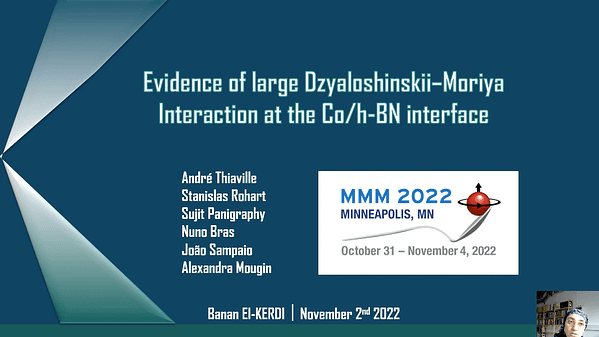Would you like to see your presentation here, made available to a global audience of researchers?
Add your own presentation or have us affordably record your next conference.
Amorphous magnetic systems provide a unique platform to study dynamics of exotic spin-textures which are fundamentally intriguing and potentially promising for
spintronics. A key question to address is how symmetric and anti-symmetric exchange coupling between atomic spins modulate the length scale of fluctuations near critical phase transition
points 1, 2. Amorphous Fe-Ge thin films is a prototype system whereby controlling the Fe concentration one can tune the magnitude and randomness of the symmetric Heisenberg
exchange and anti-symmetric Dzyaloshinskii-Moriya interaction (DMI) respectively 3, 4. In this work we performed soft x-ray photon correlation spectroscopy (XPCS) measurements to
probe the nanoscale magnetic fluctuations of stripe domains in amorphous FexGe1−x
thin films for x=0.51, 0.52 and 0.53 5, 6. At lower temperatures all the domains remain static but
with increase in temperature few domains of certain length scales start showing higher fluctuations indicative of intermittent behavior. As temperature reaches the phase transition, domains
of all length scales fluctuate collectively with increased magnitude showing the scale invariance nature at critical points. For similar reduced temperature, we observed dramatically
activated fluctuations for Fe = 0.51 concentration. Such enhanced fluctuations away from the critical temperature could be driven by the proximity from a critical point that is quantum in
origin 7. The higher instability of the stripe domains with lowering in Fe concentration also corroborate the increased resistivity trend previously observed in those systems 3.
References
1]. J. Wild, T. N. G. Meier, S. Pöllath, Science Advances., 3, e1701704 (2017)
2]. L. Shen, M. Seaberg, E. Blackburn, MRS Advances., 6, 221, (2021)
3]. D. S. Bouma, Z. Chen, B. Zhang, Phys. Rev. B., 101, 014402 (2020)
4]. R. Streubel, D. S. Bouma, F. Bruni, Advanced Materials., 33, 2004830 (2021)
5].S. K. Sinha, Z. Jiang, and L. B. Lurio, Advanced Materials., 26, 7764 (2014)
6]. M. Holt, M. Sutton, P. Zschack, Physical Review Letters., 98, 065501 (2007).
7]. Y. Feng, J. Wang, R. Jaramillo, Proceedings of the National Academy of Sciences., 109, 7224, (2012)

Figure 1. (a) Magnified images of the speckle pattern evolution at 210K for Fe = 0.52 from 1.9 sec to 1900 sec. Light blue and red color dotted circles showing a static and a dynamic portion respectively of the speckle pattern. Mean intensity (gray colormap) and temporal heterogeneity (jet colormap) of (b, d, f & c, e, g) Fe0.51Ge0.49 and (h, j, l & i, k, m) Fe0.53Ge0.47 at different temperatures. With increase in temperature more speckles fluctuate with higher amplitude. Red boxes in (b, h) maps the mean intensity with (c, i) fluctuation heterogeneity for same Qr positions.
